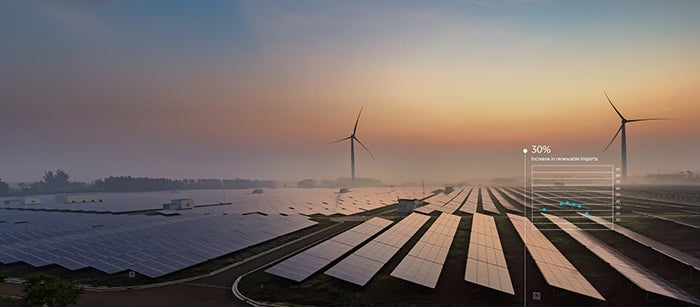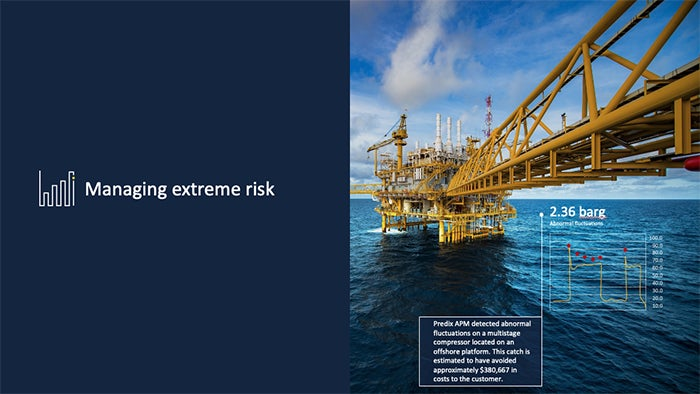How GE Digital Kept Its Rebrand on Track with Adobe Stock

Images courtesy of GE Digital.
Earlier this year, GE Digital kicked off a complete rebrand. By March, we had developed an initial messaging document and anthem video, and we were half-way through our new brand deck. Then, COVID-19 hit and our world suddenly became very different. Our team moved to remote work, and all campaign shoots for the year, all events-based programming, anything that involved travel or sending a crew to a physical space, were cancelled.
All this raised a major issue from a creative standpoint, especially for a company that has for years relied on shoots in the field to create our photos, videos, and marketing content. Most of our imagery comes from hard to access industrial locations, like factories, power generation facilities, and water utilities. Without the option to visit these venues, we had to adapt our approach, and do so quickly.
Lock, Stock, and barrel
GE Digital has a large existing library of high-quality imagery, putting us in a strong position to push ahead, but we needed to augment and support our original assets with additional imagery to continue developing new content at scale.
That’s why we turned to Adobe Stock. As a team, we have a very clear idea of what makes images right for GE Digital, but under COVID we needed to balance that vision with the reality that we can’t use the same visuals over and over again, because that causes fatigue for our audience. With Adobe Stock, we were able to find images that fit right in with our brand, helping us to build a consistent and robust content engine.
Don’t replace, complement
There were challenges, of course. GE has a rich history of industrial photography, with a certain authenticity that comes from giving our audience behind the scenes access to facilities that are usually off limits.

Our design approach used to mean walking the floor of a factory and understanding how it works. Every element of our shoot schedule, which subjects we focused on, and all our production methods all stemmed from that mentality. When working with Stock, our goal was to preserve that authenticity. Instead of replacing what makes GE unique, we wanted to complement our images with ones that don’t feel like stock, and that convey our story in the way we want to tell it.
Because we have such a large, high quality image library, we have a very clear definition of what works for GE Digital. This ensured that mixing our own photos with Adobe Stock would continue to deliver compelling content that rings true for our audience. For instance, we would focus on images that felt a bit candid and ones that represented actual use cases an operator would encounter when using our software in the field.
Fundamentally, at GE Digital we aim to capture the environment where our technology runs and showcase the people who use it. But there’s also a gritty personality to the imagery we use. Our customers don’t use their software in coffee shops; they’re on oil rigs, production lines, and control rooms. We therefore make a point of avoiding images that feel removed from these worlds, or that just focus on technology without context.
There is also the safety factor that goes with every industrial environment. Operators take extreme precaution in everything they do, and that’s something we need to represent in our imagery as well. More recently, we’ve found that customers appreciate data overlays in our visuals, which allow us to combine beautiful imagery with relevant information. For these data-rich images, having some flexibility with composition is key.
Remote, but not restricted
Working with Stock has also made us more efficient. Our team is certainly eager to get back to work safely, but this new approach to content creation has seen us produce visual assets more quickly than ever, without sacrificing on quality.
I work with an incredibly talented team of writers and communications experts, operating at a weekly cadence that’s similar to that of a newsroom. Together, we develop internal content series focused on our employees, our technology, and leadership. On top of that are the stories we roll out externally, which focus on our customers, our products, and the industries we serve.
Every piece we develop for these series needs an image, which would historically take us three to four weeks to create following a shoot. Once ready, we would then use that image across our customer, product and industry content. Adobe Stock has been invaluable in this final category, making it possible to find images that speak to a specific industry in just hours instead of weeks.
Check out industrial images on Adobe Stock.
Of course, shoots will always be an integral part of GE Digital’s creative process, but Stock has helped us to stay creative while making life easier for our team and reducing the burden on our employees in the field.
Getting smart with search
Adobe Stock galleries offer millions of photos to choose from, ranging from simple images of industrial settings to close-up shots of technology in use. That means we have an incredible amount of source material at our fingertips, but the danger is that we spend more time searching for the perfect image than we do creating the content itself.
One of the beauties of Adobe Stock is that advanced search capabilities allow for greater focus and specificity than other libraries. With Adobe Sensei AI built directly into the software, we can use image-based search, lifted color palettes, and more to refine our parameters and find the images we need more quickly. A major time-saver for my team has been the ability to look for images that work well with text overlays, which can otherwise be a real time-drain. When we find an image, we can use the Preview Crop feature to instantly see if there’s enough space where we need it for the text we plan to use.

Image source: Adobe Stock / Before sunrise solar power plants by 一飞 黄.
Back to basics
COVID-19 has changed the way we work, on top of which working remotely comes with its own set of challenges, but this situation has also given us a unique perspective on what matters most to GE Digital and our storytelling.
This is a time for marketers to focus on what’s important to their brand. We don’t have time to develop content that doesn’t serve our audience’s immediate needs. Luckily, there are loads of good source material out there, and we just need to piece it together in a way that makes sense for our company.
For GE Digital, that has meant going back to basics and doubling down-on effective storytelling. By combining the best of our own resources with a strategic approach to Stock, we’ve positioned ourselves to adapt and stay true to our aims, both as a brand and as an organization.
For more information, watch this webinar on demand: Content Velocity Without Creative Compromise
GE Digital’s Senior Creative Director Philip Stockton talks about his experience successfully navigating his team through the challenges of content velocity during the age of “shelter at home” and getting the best photos without conducting photoshoots in the field.

Image source: Adobe Stock / Offshore oil and gas rig platform by JT Jeeraphun.